A Strain-Transfer Model of Surface-Bonded Sapphire-Derived Fiber Bragg Grating Sensors
Abstract
1. Introduction
2. Theoretical Approach
- 1)
- The SDF core, cladding, adhesive layer, and monitored substrate were to be made of linear, elastic, homogeneous materials.
- 2)
- The adhesive layer was to be closely bonded to the SDF and substrate materials, with no relative slip. Shear stress and displacement at the interface between the two different media were to be at the same amplitude.
- 3)
- Both the adhesive layer and the cladding layer were to only be subject to shear strain. This is because the Young’s modulus of the adhesive layer and the cladding layer would be much smaller than that of the heavily doped alumina core and the substrate material.
3. Finite Element Analysis
4. Experiment and Discussion
5. Conclusions
Author Contributions
Funding
Conflicts of Interest
References
- Zhang, X.; Peng, W.; Shao, L.; Pan, W.; Yan, L. Strain and temperature discrimination by using temperature-independent FPI and FBG. Sensor. Actuat. A Phys. 2018, 272, 134–138. [Google Scholar] [CrossRef]
- Liu, Y.; Wang, D. Fiber in-line Fabry-Perot interferometer with offset splicing for strain measurement with enhanced sensitivity. IEEE Photonic. J. 2018, 10, 1–8. [Google Scholar] [CrossRef]
- Tian, K.; Farrell, G.; Wang, X.; Yang, W.; Xin, Y.; Liang, H.; Lewis, E.; Wang, P. Strain sensor based on gourd-shaped single-mode-multimode-single-mode hybrid optical fibre structure. Opt. Express. 2017, 25, 18885–18896. [Google Scholar] [CrossRef] [PubMed]
- Liu, Y.; Lang, C.; Wei, X.; Qu, S. Strain force sensor with ultra-high sensitivity based on fiber inline Fabry-Perot micro-cavity plugged by cantilever taper. Opt. Express. 2017, 25, 7797–7806. [Google Scholar] [CrossRef]
- Liu, Y.; Qu, S.; Qu, W.; Que, R. A Fabry–Perot cuboid cavity across the fibre for high-sensitivity strain force sensing. J. Optics 2014, 16, 1054011–10540117. [Google Scholar]
- Leal-Junior, A.G.; Theodosiou, A.; Min, R.; Casas, J.; Diaz, C.R.; Dos Santos, W.M.; Pontes, M.J.; Siqueira, A.A.G.; Marques, C.; Kalli, K.; et al. Quasi-distributed torque and displacement sensing on a series elastic actuator’s spring using FBG arrays inscribed in CYTOP fibers. IEEE Sens. 2019, 19, 4054–4061. [Google Scholar] [CrossRef]
- Zhang, X.; Chen, J.; González-Vila, Á.; Liu, F.; Liu, Y.; Li, K.; Guo, T. Twist sensor based on surface plasmon resonance excitation using two spectral combs in one tilted fiber Bragg grating. J. Opt. Soc. Am. B 2019, 36, 1176. [Google Scholar] [CrossRef]
- Farhad, A.; Yuan, L. Mechanics of bond and interface shear transfer in optical fiber sensors. J. Eng. Mech. 1998, 124, 385–394. [Google Scholar]
- Li, J.; Zhou, Z.; Ou, J.P. Interface transferring mechanism and error modification of embedded FBG strain sensor. Smart Structures and Materials, San Diego, United States, 2004; Udd, E., Li, J., Inaudi, D., Zhou, Z., Ou, J.P., Eds.; SPIE: Bellingham, WA, USA, 2004. [Google Scholar]
- Wu, R.; Zheng, B.; Fu, K.; He, P.; Tan, Y. Study on strain transfer of embedded fiber Bragg grating sensors. Opt. Eng. 2014, 53, 0851051–0851056. [Google Scholar] [CrossRef]
- Liang, M.; Chen, N.; Fang, X.; Wu, G. Strain transferring mechanism analysis of the surface-bonded FBG sensor. Appl. Opt. 2018, 57, 5837–5843. [Google Scholar] [CrossRef]
- Her, S.; Huang, C. The effects of adhesive and bonding length on the strain transfer of optical fiber sensors. Appl. Sci. 2016, 6, 13. [Google Scholar] [CrossRef]
- Wan, K.T. Quantitative sensitivity analysis of surface attached optical fiber strain sensor. IEEE Sens. 2014, 14, 1805–1812. [Google Scholar] [CrossRef]
- Zhou, J.; Zhou, Z.; Zhang, D. Study on strain transfer characteristics of fiber Bragg grating sensors. J. Intel. Mat. Syst. Str. 2010, 21, 1117–1122. [Google Scholar] [CrossRef]
- Zhao, H.; Wang, Q.; Qiu, Y.; Chen, J.; Wang, Y.; Fan, Z. Strain transfer of surface-bonded fiber Bragg grating sensors for airship envelope structural health monitoring. J. Zhejiang Univ. Sci. A 2012, 13, 538–545. [Google Scholar] [CrossRef]
- Wang, H.; Xiang, P. Strain transfer analysis of optical fiber based sensors embedded in an asphalt pavement structure. Meas. Sci. Technol. 2016, 27, 075106. [Google Scholar] [CrossRef]
- Li, D.; Li, H.; Ren, L.; Song, G. Strain transferring analysis of fiber Bragg grating sensors. Opt. Eng. 2006, 45, 024402. [Google Scholar] [CrossRef]
- Wang, H.; Jiang, L.; Xiang, P. Improving the durability of the optical fiber sensor based on strain transfer analysis. Opt. Fiber. Technol. 2018, 42, 97–104. [Google Scholar] [CrossRef]
- Li, H.; Zhu, L.; Dong, M.; Lou, X.; Guo, Y. Analysis on strain transfer of surface-bonding FBG on Al 7075-T6 alloy host. Optik 2016, 127, 1233–1236. [Google Scholar] [CrossRef]
- Wang, Z.; Li, H.; Zhang, L.; Xue, J. Strain transfer characteristic of a fiber Bragg grating sensor bonded to the surface of carbon fiber reinforced polymer laminates. Appl. Sci. 2018, 8, 1171. [Google Scholar] [CrossRef]
- Shen, W.; Wang, X.; Xu, L.; Zhao, Y. Strain transferring mechanism analysis of the substrate-bonded FBG sensor. Optik 2018, 154, 441–452. [Google Scholar] [CrossRef]
- Wan, K.T.; Leung, C.K.Y.; Olson, N.G. Investigation of the strain transfer for surface-attached optical fiber strain sensors. Smart. Mater. and Struct. 2008, 17, 035037. [Google Scholar] [CrossRef]
- Wang, H.P.; Xiang, P.; Li, X. Theoretical analysis on strain transfer error of FBG sensors attached on steel structures subjected to fatigue load. Strain 2016, 52, 522–530. [Google Scholar] [CrossRef]
- Her, S.C.; Huang, C.Y. Effect of coating on the strain transfer of optical fiber sensors. Sensors (Basel) 2011, 11, 6926–6941. [Google Scholar] [CrossRef] [PubMed]
- Dragic, P.D.; Hawkins, T.; Foy, P.; Morris, S.; Ballato, J. Sapphire-derived all-glass optical fibres. Nat. Photonics 2012, 6, 627–633. [Google Scholar] [CrossRef]
- Zhang, P.; Zhang, L.; Wang, Z.; Zhang, X.; Shang, Z. Sapphire derived fiber based Fabry-Perot interferometer with an etched micro air cavity for strain measurement at high temperatures. Opt. Express 2019, 27, 27112–27123. [Google Scholar] [CrossRef]
- Liu, H.; Pang, F.; Hong, L.; Ma, Z.; Huang, L.; Wang, Z.; Wen, J.; Chen, Z.; Wang, T. Crystallization-induced refractive index modulation on sapphire-derived fiber for ultrahigh temperature sensing. Opt. Express 2019, 27, 6201. [Google Scholar] [CrossRef]
- Zhang, P.; Zhang, L.; Mourelatos, Z.P.; Wang, Z. Crystallization-sapphire-derived-fiber-based Fabry-Perot interferometer for refractive index and high-temperature measurement. Appl. Opt. 2018, 57, 9016–9021. [Google Scholar] [CrossRef]
- Elsmann, T.; Lorenz, A.; Yazd, N.S.; Habisreuther, T.; Dellith, J.; Schwuchow, A.; Bierlich, J.; Schuster, K.; Rothhardt, M.; Kido, L.; et al. High temperature sensing with fiber Bragg gratings in sapphire-derived all-glass optical fibers. Opt. Express 2014, 22, 26825–26833. [Google Scholar] [CrossRef]
- Dragic, P.; Ballato, J.; Ballato, A.; Morris, S.; Hawkins, T.; Law, P.C.; Ghosh, S.; Paul, M.C. Mass density and the Brillouin spectroscopy of aluminosilicate optical fibers. Opt. Mater. Express 2012, 2, 1641–1654. [Google Scholar] [CrossRef]
- Wang, Q.; Qiu, Y.; Zhao, H.; Chen, J.; Wang, Y.; Fan, Z. Analysis of strain transfer of six-layer surface-bonded fiber Bragg gratings. Appl. Opt. 2012, 51, 4129–4138. [Google Scholar] [CrossRef]
- Sirkis, J.S. Unified approach to phase-strain-temperature models for smart structure interferometric optical fiber sensors: Part 1, development. Opt. Eng. 1993, 32, 752. [Google Scholar] [CrossRef]
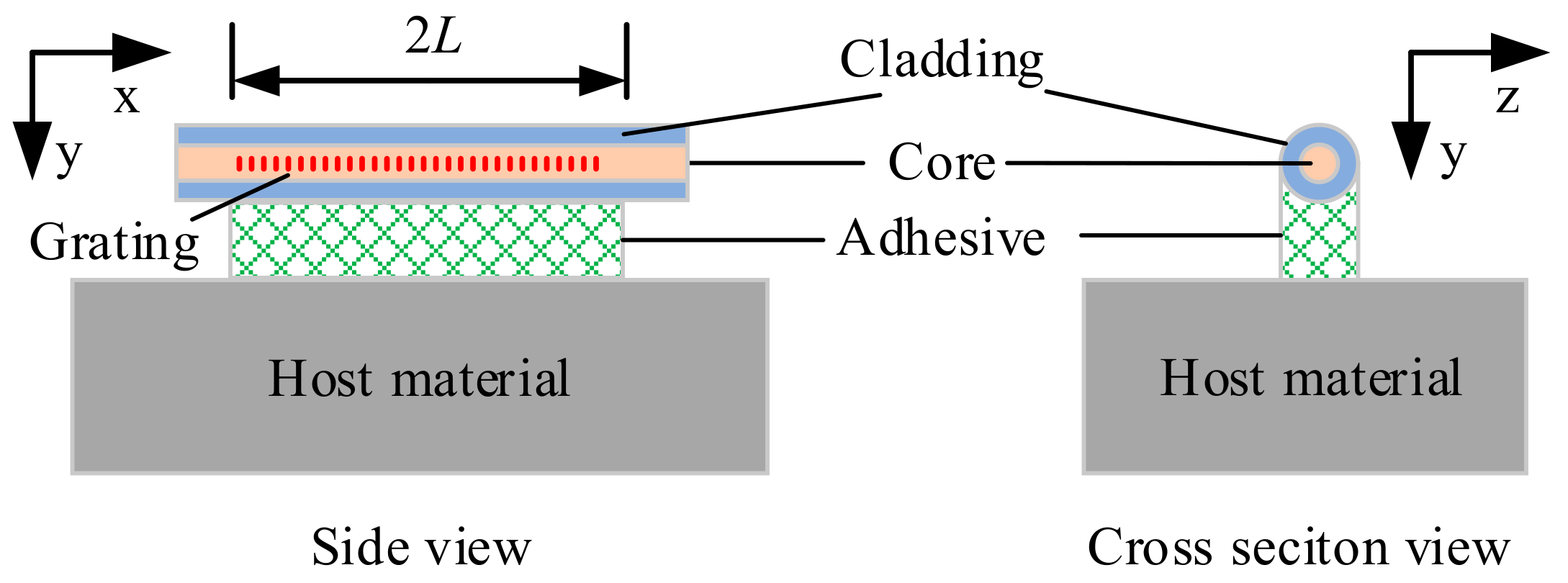
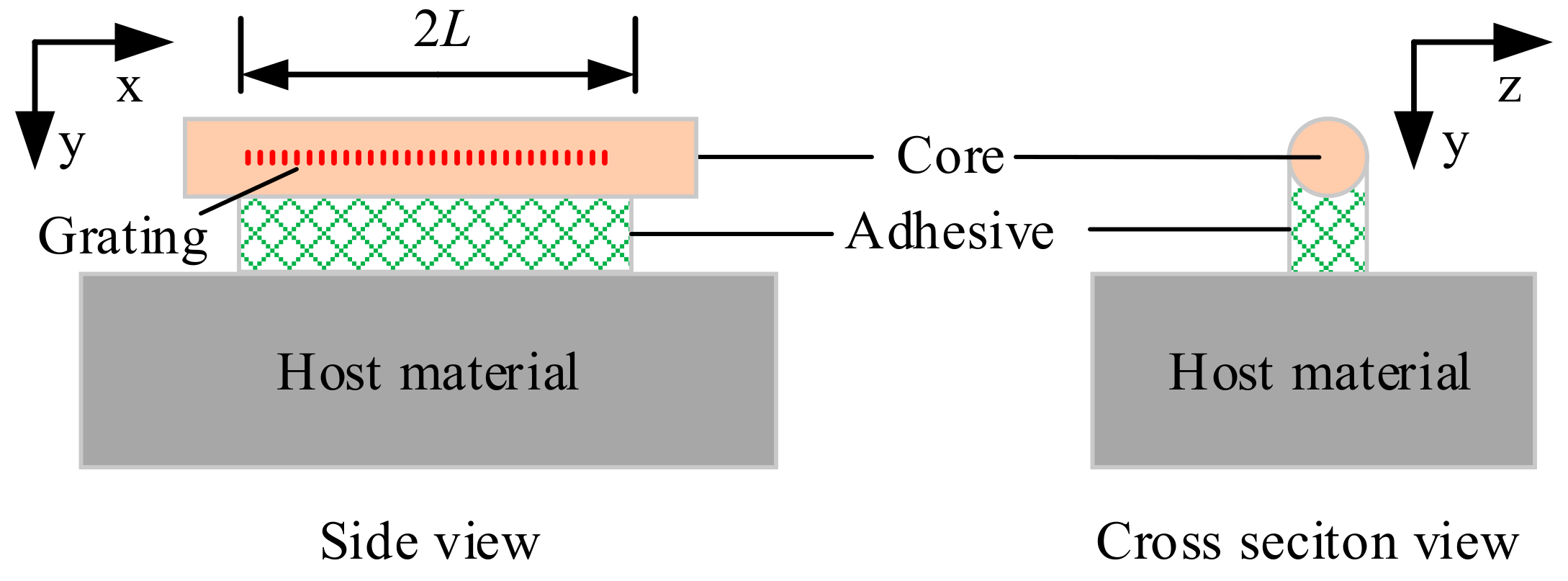
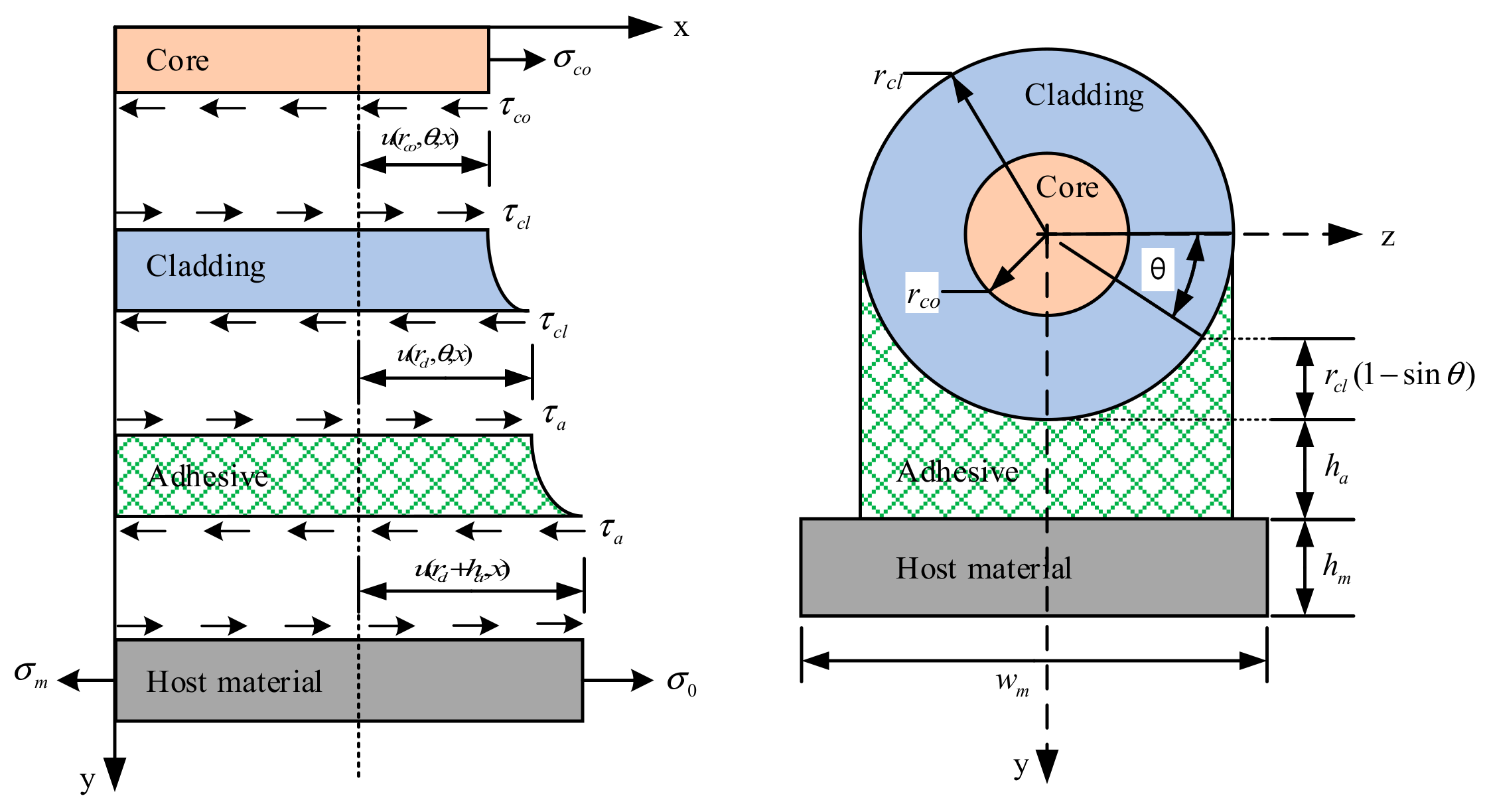
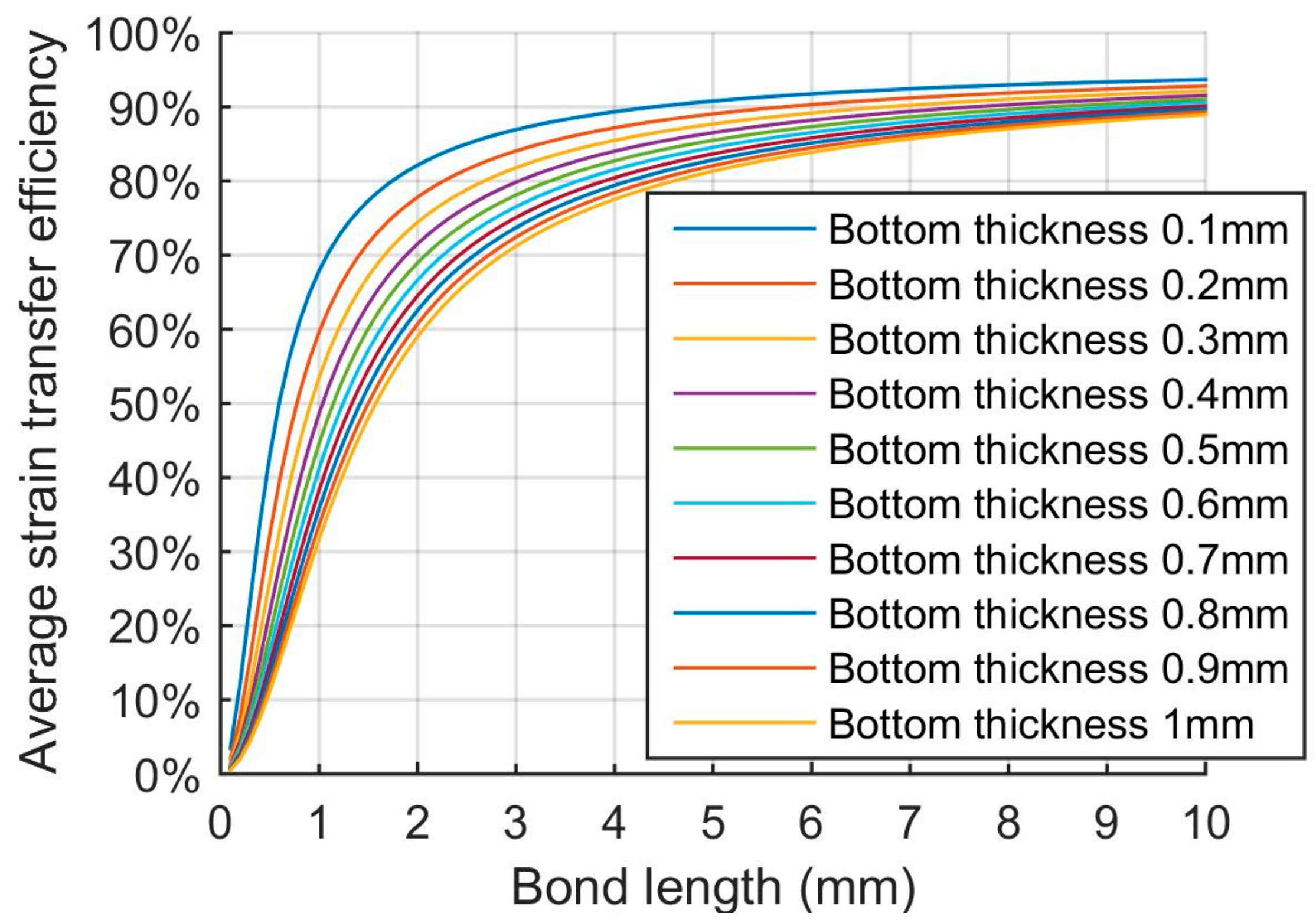
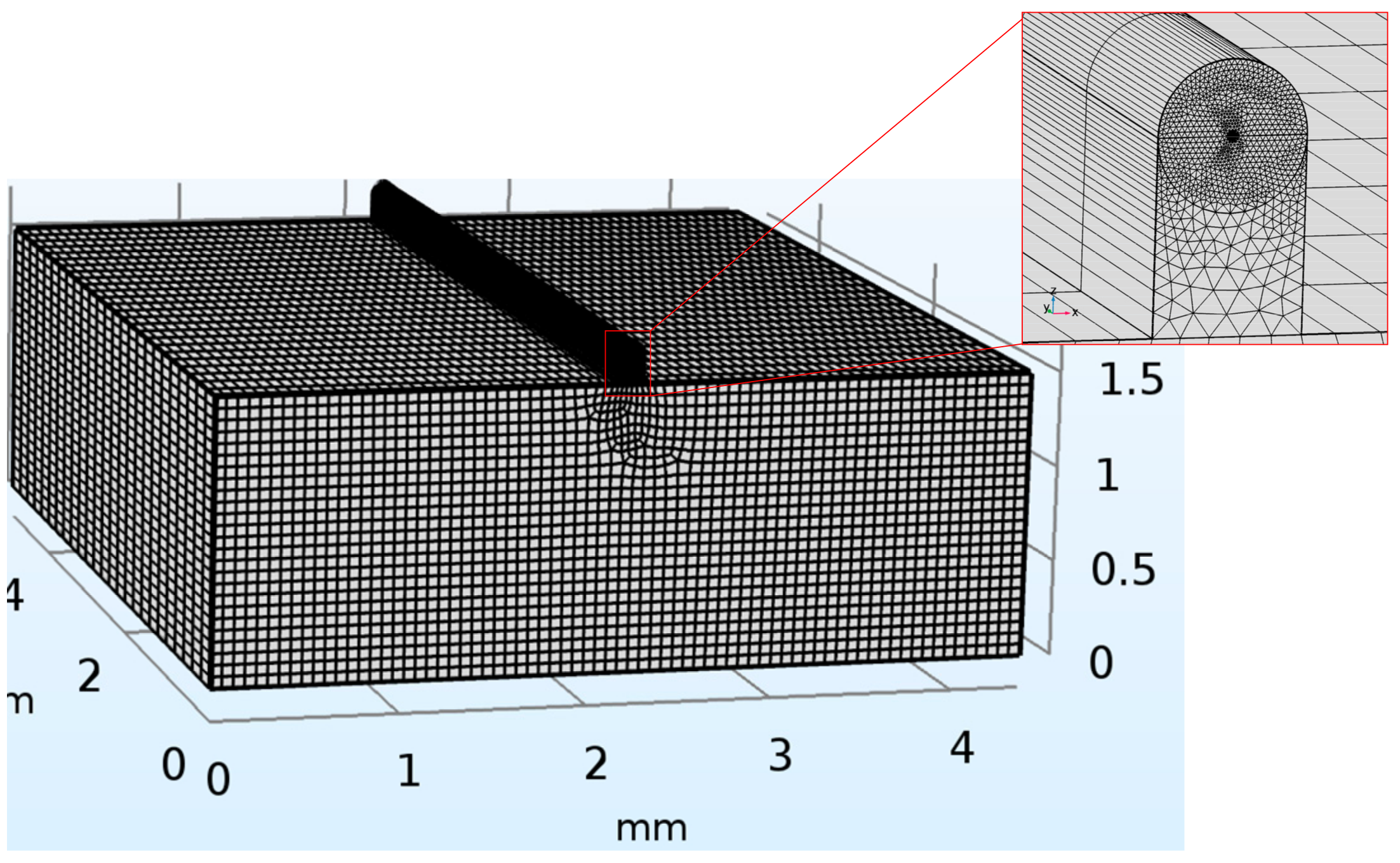
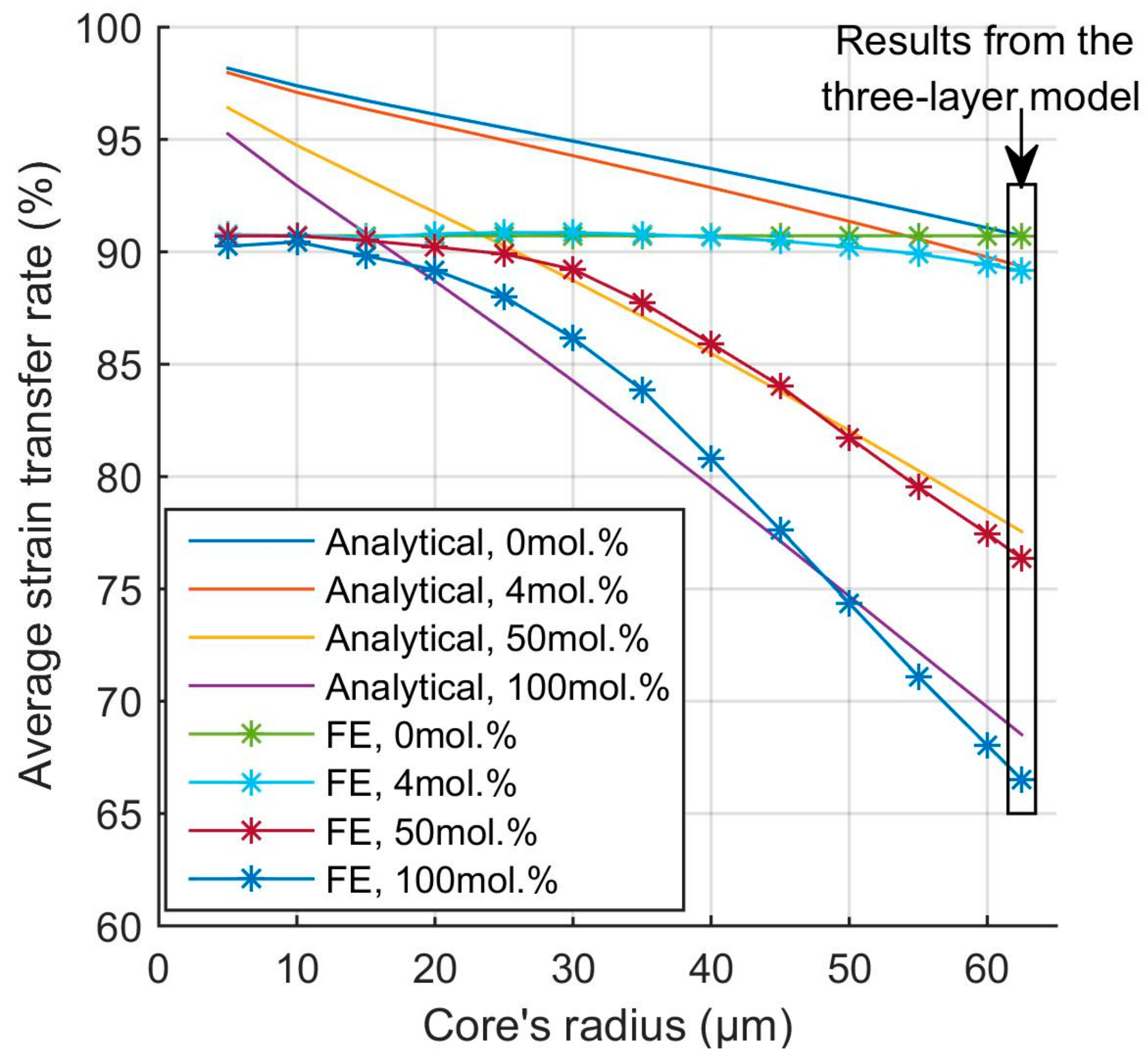
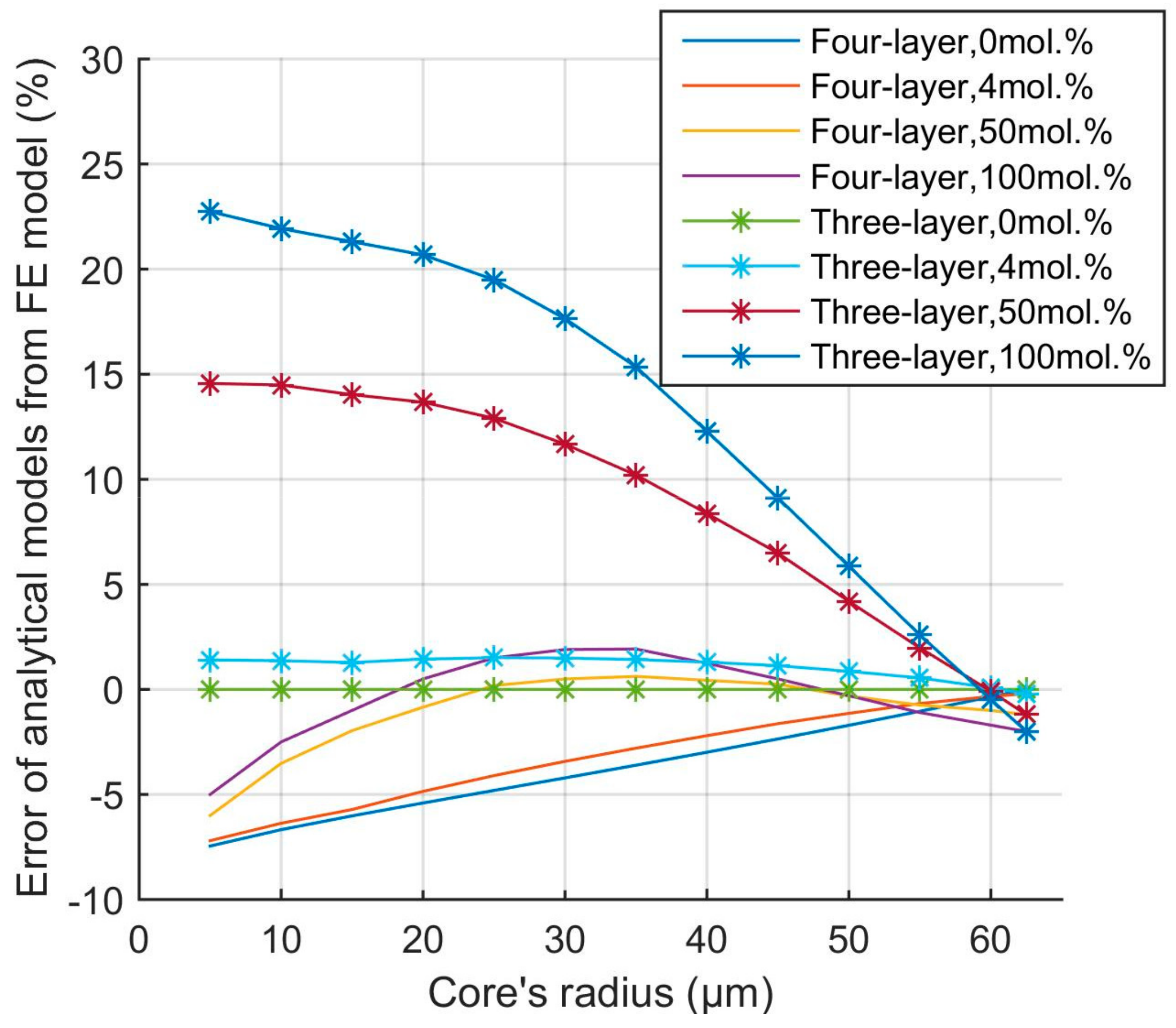
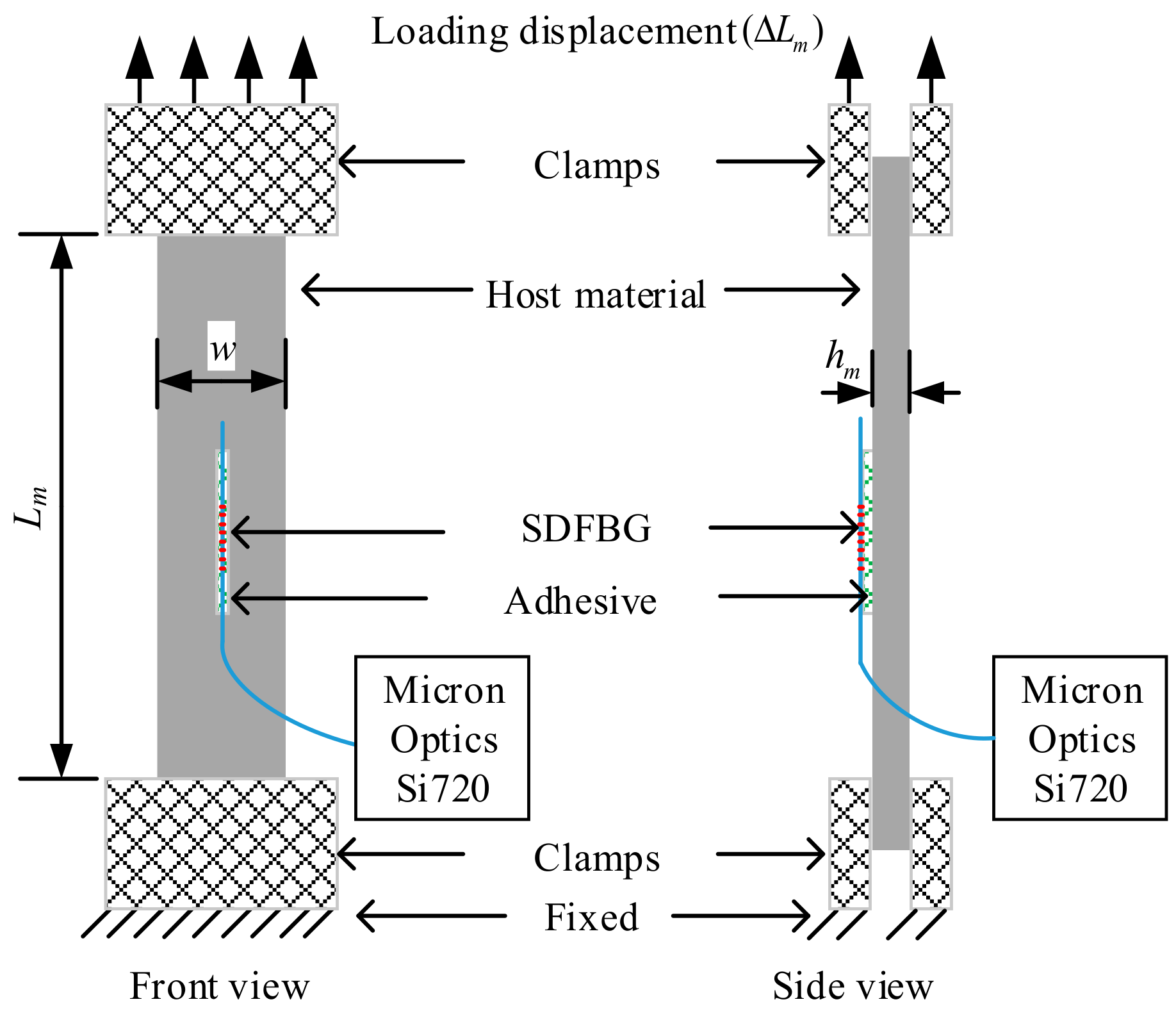
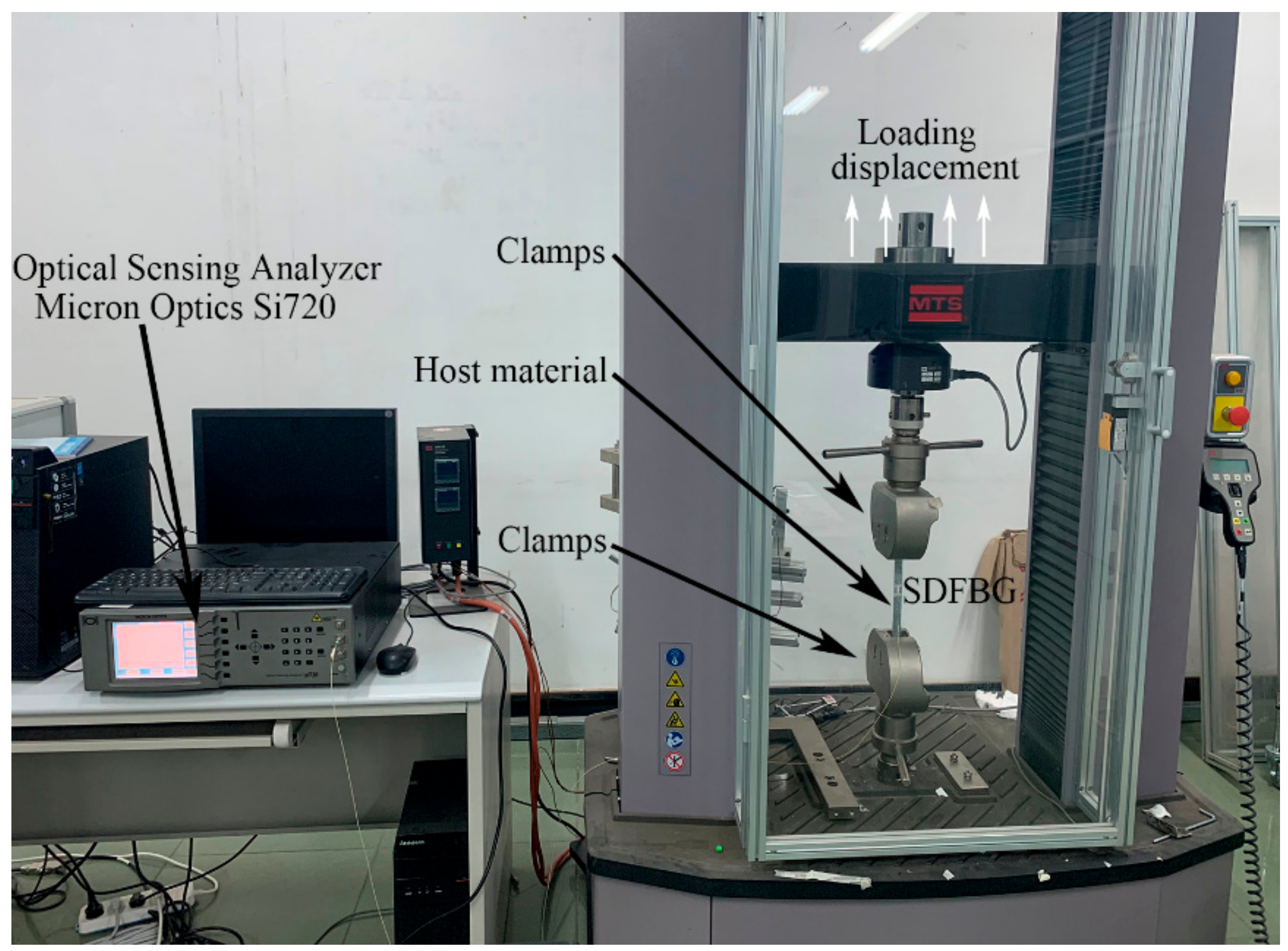
| Sapphire | Silica | Adhesive | Host Material | |
|---|---|---|---|---|
| E(GPa) | 503 | 72 | 10 | 195 |
| μ | 0.25 | 0.17 | 0.34 | 0.24 |
| rco | rcl | hm | wm | |
|---|---|---|---|---|
| Size (mm) | 0.0625 | 0.0625 | 1.5 | 4.4 |
| Alumina Content (mol %) | Core Radius (μm) | Cladding Radius (μm) | |
|---|---|---|---|
| SDFBG-1 | 49.6 | 30.8 | 62.5 |
| SDFBG-2 | 49.3 | 10.5 | 62.5 |
| SDFBG-3 | 4.5 | 30.2 | 62.5 |
| Material | n | ν | p11 | p12 |
|---|---|---|---|---|
| Al2O3 | 1.667 | 0.25 | −0.237 | −0.027 |
| SiO2 | 1.444 | 0.16 | 0.098 | 0.226 |
| Theoretical Sensitivity (pm/με) | Experiment Sensitivity (pm/με) | Experiment ASTR (%) | FE Model | Four-Layer Model | Three-Layer Model | ||||
|---|---|---|---|---|---|---|---|---|---|
| ASTR (%) | Error 1 (%) | ASTR (%) | Error 1 (%) | ASTR (%) | Error 1(%) | ||||
| SDFBG-1 | 1.37 | 1.19 | 86.9 | 87.4 | 0.5 | 87.8 | 0.9 | 77.7 | 9.2 |
| SDFBG-2 | 1.37 | 1.26 | 92.3 | 92.1 | 0.2 | 93.1 | 0.8 | 77.6 | 14.7 |
| SDFBG-3 | 1.29 | 1.16 | 90.5 | 91.6 | 1.1 | 95.7 | 5.2 | 90.2 | 0.3 |
© 2020 by the authors. Licensee MDPI, Basel, Switzerland. This article is an open access article distributed under the terms and conditions of the Creative Commons Attribution (CC BY) license (http://creativecommons.org/licenses/by/4.0/).
Share and Cite
Zhang, P.; Zhang, L.; Wang, Z.; Chen, S.; Shang, Z. A Strain-Transfer Model of Surface-Bonded Sapphire-Derived Fiber Bragg Grating Sensors. Appl. Sci. 2020, 10, 4399. https://doi.org/10.3390/app10124399
Zhang P, Zhang L, Wang Z, Chen S, Shang Z. A Strain-Transfer Model of Surface-Bonded Sapphire-Derived Fiber Bragg Grating Sensors. Applied Sciences. 2020; 10(12):4399. https://doi.org/10.3390/app10124399
Chicago/Turabian StyleZhang, Penghao, Li Zhang, Zhongyu Wang, Shuang Chen, and Zhendong Shang. 2020. "A Strain-Transfer Model of Surface-Bonded Sapphire-Derived Fiber Bragg Grating Sensors" Applied Sciences 10, no. 12: 4399. https://doi.org/10.3390/app10124399
APA StyleZhang, P., Zhang, L., Wang, Z., Chen, S., & Shang, Z. (2020). A Strain-Transfer Model of Surface-Bonded Sapphire-Derived Fiber Bragg Grating Sensors. Applied Sciences, 10(12), 4399. https://doi.org/10.3390/app10124399




